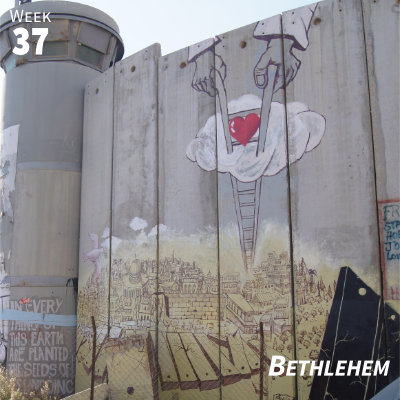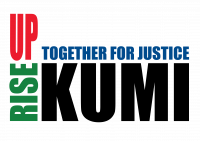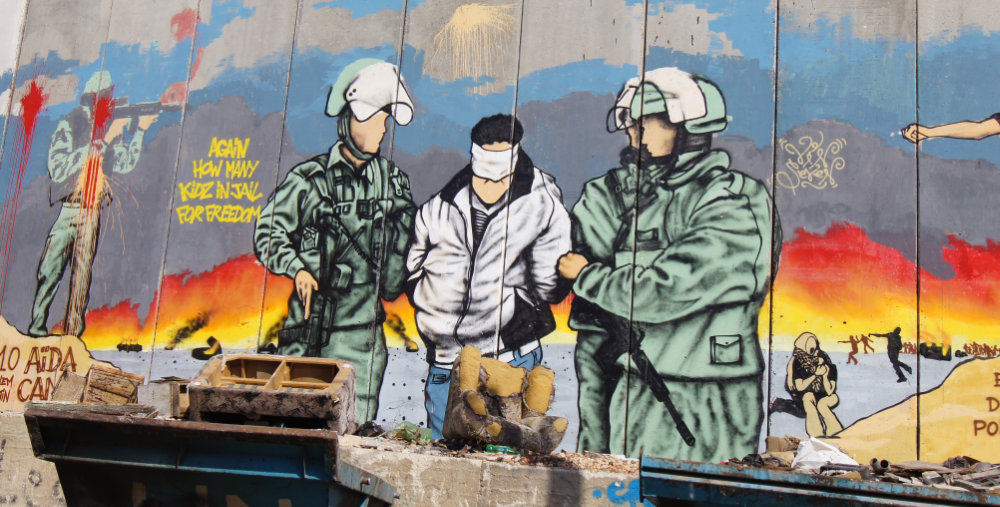Week 37: Bethlehem

Rachel’s Tomb, at the north end of Bethlehem, is of religious significance for Christians, Jews, and Muslims alike. But Israel has illegally annexed the tomb area, enclosing it with a wall and denying Palestinians access. Israel approved plans to enclose Rachel’s Tomb on September 11, 2002. As we mark this travesty of what should be a Palestinian cultural and religious site, open to all, here’s what you need to know about the effects of occupation and Jewish settlement on Bethlehem and what you can do so that together we can rise up.
Topic: Bethlehem
Once the area around Rachel’s Tomb, a pilgrimage place for Muslims, Christians, and Jews, was one of the liveliest in Bethlehem, located in the occupied West Bank. The Hebron Road connected Jerusalem with Bethlehem, and its northern section was in fact the busiest street in town. It was the gate from Jerusalem into Bethlehem. After entering Bethlehem along the main road, visitors either chose the direction to Hebron or the road to the Church of the Nativity.
The reality now is different. During the 1990s Rachel’s Tomb developed into an Israeli military stronghold with the imposing Jerusalem-Bethlehem checkpoint close by. As such, it became the focus of Palestinian protests, especially during the Second Intifada that started in September 2000. Two years later, Israel annexed the Tomb area to Jerusalem. In the period 2002–2005 Israel built walls around it, as well as a nearby parking lot. The Tomb became forbidden territory to inhabitants of Bethlehem. Since 2000 no less than 64 shops, garages, and workshops along the Hebron Road closed their gates. This was not just because of the fighting, shootings, and shelling going on during the Second Intifada, but also because the area became desolate as a result of the wall. People still remember that parents warned their children not to visit the area with its imposing 8 to 9 meter high concrete wall—almost twice as high as the former Wall in Berlin.
This description of Rachel’s Tomb and the effects of occupation on the surrounding area comes from AEI’s entry for Kumi Now. However, it is just one account of the many effects that the illegal occupation and settlements are having on Bethlehem and the surrounding area.
In total, approximately 20 Israeli settlements (some are in the process of being built) ring the city of Bethlehem. To the west, the apartheid wall is built in Palestine, well within the Green Line, granting Israeli settlements full control of 11.6% of the land of Bethlehem. Add to this Road 60, the settler-only road that further cuts western Bethlehem from its center, and Road 356, which cuts eastern Bethlehem from its center. Additional Israeli settlements lie in eastern Bethlehem, giving Palestinians full control over only 13% of the land of Bethlehem.
Ghada Karmi calls this cutting up of Bethlehem “Israel’s brutal vandalism,” writing, “Leaving Jerusalem southwards to travel the nine kilometre distance to Bethlehem, I took a wrong turn and found myself on a fast, modern highway without another Palestinain driver in sight.
“I had stumbled by accident onto a Jews-only settler bypass road, one of two that skirt Bethlehem and connect with its encircling settlements. I soon realized the purpose of the operation: to pretend that no one else exists in the area but Jews.”
One settlement, in northern Bethlehem, is “Har Homa, a settlement that until 2000 was an ancient, densely wooded hill called Jabal Abu Ghneim. Israel uprooted the trees and replaced them with a colony of dreary, box-like houses, which it threatened to turn into a Bethlehem lookalike for tourists.”
She notes too the ways in which the occupation has stunted Bethlehem economically: “Since 2015 Israel has closed off Bethlehem’s fertile Cremisan Valley to its Palestinian owners … It was also a rich agricultural area with a successful wine industry. But most of its land has been confiscated, and draconian restrictions on movement to and from Bethlehem have reduced tourism and pilgrim numbers drastically. Today its population (has) the highest unemployment rate in the occupied territories, second only to that of Gaza.”
In short, “Israel’s relentless penetration to the heart of Bethlehem is unmistakable. Bethlehem is deliberately isolated behind the formidable separation barrier, surrounded by checkpoints, and its economy strangulated. Its main source of prosperity had been tourism with two million annual visitors and a thriving souvenir market of classic olive wood and mother-of-pearl carvings.”
However, even this dependence on tourism is controlled by Israel, with Israeli tour companies and hotels garnering much of the economic benefit of this tourism and controlling the narrative that is presented to tourists. Megan Giovannetti examines how Israel controls the narrative on Bethlehem through Christmas in an article for Al Jazeera. This control begins with the licensing of tour guides, almost all of whom are Israelis, and continues as the time tourists spend in Bethlehem is, according to a ministry representative, “divided between the church and the souvenir shop…Not only do Israeli tour guides control what is said, but they also limit opportunities for tourists to interact with locals and the Palestinian city in general.” A vast majority of those tourists also spend their nights, and thus a large chunk of their tourists dollars, at hotels in Israel, despite the availability of beds in Bethlehem.
Given Bethlehem’s association with Christmas, it is fitting to end with an observation from Rev. Dr. Mitri Raheb in his sermon “Bethlehem Then and Now”:
“Bethlehem at the birth of Jesus was a besieged city. Today Bethlehem is again a besieged city surrounded from three sides by a 25 foot high concrete wall. So what if Jesus were to be born today in Bethlehem? If Jesus were to be born this year, he would not be born in Bethlehem. Mary and Joseph would not be allowed to enter from the Israeli checkpoint, and so too the Magi. The shepherds would be stuck inside the walls, unable to leave their little town. Jesus might have been born at the checkpoint like so many Palestinian children while having the Magi and shepherds on both sides of the wall.”
Bethlehem is full of stories about the impact of occupation. It is hemmed in on all sides, cut off from most of its land, and dependent on and suffering because of Israel’s control of its tourism. The story of the birth of Christ reminds us, particularly at Christmas, of the need for home and love, and of understanding between peoples. The reality of Israeli occupation, however, denies Bethlehem and its residences all of these. Through the week we will publish and share more of these stories, and highlight the organizations in Bethlehem working to end the occupation.
Story: “Hug” and “Rescue” by Melvina and Sylvana
“Hug”
During the first Intifada Israeli tanks stood in front of our house. Our young men had to pass here to reach their work places in Jerusalem. The soldiers used to stop and delay them. They were sometimes made to stand for hours with their head directed towards the wall of our house. One day, the soldiers stopped two young men. We couldn’t hear the talk but the soldiers started to beat them. Suddenly, a woman in the street came shouting and screaming. We heard her saying that the young men were her children. She hugged them and asked the soldiers what they wanted. She saved the young men whom she actually did not know.
Melvina, from Bethlehem
“Rescue”
During one of the Second Intifada days, I, a young Palestinian woman, was four months pregnant and lost my baby because of Israeli tear gas. I was terribly depressed since it was the second miscarriage I suffered. A week later I visited a medical doctor in Jerusalem for a check up. Coming out of the doctor’s clinic, I saw, nearby, on top of an escalator an Israeli child who was recklessly playing and about to fall down. Thoughts rushed through my mind. Should I leave him and let him die the way the Israeli soldiers let my boy die a week ago, or should I make a desperate attempt to grab him? All of a sudden, I felt an impulse that made me hurry forwards. Throwing myself in front of the boy I prevented his fall.
Sylvana, from Bethlehem
Kumi Action
Since 2011, the Arab Educational Institute has put some 300 large weather-resistant posters on the Wall that surrounds Rachel’s Tomb in Bethlehem. Most posters display, in English, brief true stories written by Palestinian women and youth. The stories are about restrictions and common human rights violations Palestinians have faced, but also about their sumud: Arabic for inner strength, steadfastness, or resilience. The posters together make up the “Wall Museum.”
During the last years AEI has expanded the “Wall Museum” to areas near Aida refugee camp west of Rachel’s Tomb, with lively youth stories and photos as well as children fantasies. Recently we asked Palestinian youth and women to make paintings in workshops to give expression to their longing for freedom and peace.
The Wall Museum has recently become part of a newly established Wall Information Center at AEI’s Sumud Story House in North Bethlehem. The Center gives voice to Palestinians who are directly hurt by the wall.
For your action this week, make a printout of one of the stories on the “Wall Museum” (images at https://aeicenter.org/wallposters-2/ and on Facebook and Instagram) and share it on a physical wall of your school, business, etc. To make it stand out, include a sign proclaiming “RIP, Rachel.” Or share one of the images on your metaphorical Facebook wall. For your message, simply include “RIP, Rachel.” Explain that RIP means “Rest in Palestine.”
You can also write a review of Rachel’s Tomb on Google Maps, highlighting the Palestinian version of the history of Rachel’s Tomb and the surrounding area. We suggest you use language similar to the following:
“Rachel’s Tomb is a deeply religious location to Jews, Christians, and Muslims alike. It is also located in what is supposed to be Palestinian-controlled Bethlehem. However, in the early 2000s Israel annexed the tomb area to Jerusalem, built a wall around it, and prohibited Palestinians from visiting the site. Furthermore, dozens of businesses in the area had to close their doors.
All people deserve access to the sites they consider holy. Please keep this in mind when visiting Rachel’s Tomb and help spread the full story of Rachel’s Tomb.”
And if you are able to visit Rachel’s Tomb in person include photos with your review that highlight the art of the “Wall Museum.”
Take a photo of your own “Wall Museum” and share it on social media. Include a link to this page of the Kumi Now website along with the hashtags #RIPRachel, #StoptheWall, #KumiNow, and #Kumi47.
Literature: “Israel’s Reaction to the Notion of Peace on Palm Sunday” by Dr. Mazin Qumsiyeh
Wow, what a day: over 100 native Palestinian Christians and Muslims and internationals including Israelis, breached the tight security separating the Palestinian cities of Bethlehem from the occupied city of Jerusalem.
Donkeys and people arrested! We were initially some 150 strong and started from the Church of Nativity at 11:45 carrying palm leaves and banners asking for freedom of worship and movement (as demanded by international law). The demonstration included individuals riding 2 donkeys and a horse. Appropriate, since Jesus entered Jerusalem on a donkey.
Like him, we knew this was not going to be an easy entry but we did believe in the goodness of humanity. We arrived at the main gate used for tourist buses at around 12:30 and decided to just keep going. The few soldiers and police at the gate tried to close it but we managed to get in and the huge 8 meter high metal gate stopped half-way, perhaps as a safety mechanisms since there were dozens of people passing and they could be crushed if it continued.
The Israeli security forces tried to close other fences but we kept going. As word reached their offices, the Israeli army was mobilizing its forces and soon several army jeeps arrived and blocked the road half-way between the gate and Deir Mar Elias (the monastery at the edge of the city). They blocked our way. Ibrahim Salah riding his donkey was speaking to them in Hebrew and saying, “Why can’t we go to Jerusalem? It is our right to travel.”
He was the first to be violently knocked down off his donkey and arrested. The next was an American girl, then some Palestinians. All violently wrestled to the ground when even many were just peacefully walking back to the gates. It seemed like a calculated move to punish some of us so that others get the message not to try this again.
Some 60 of us ended up being rounded up in between a wall, a hill, a gate, and a cordon of police officers. We expected to be all arrested. The occupation soldiers instead plucked random people that they thought were the key people.
We had significant local and national and international media coverage. The people are willing to pay the price. Israeli forces released 4 Israelis and the one American student. They kept 11 Palestinians and are charging them with “incitement”, “participating in an unauthorized demonstration” “entering ‘Israel’ without a permit (as if occupied Arab East Jerusalem is Israel)”, and “interfering in police business”.
Lawyers will show that this is all bogus. But in any case, the popular resistance movement is growing and is willing to pay the price for such significant achievement as this. The repression only strengthened our collective will to move forward. We were all elated at this success. We know some Israeli officers; maybe the private “security” company that is contracted by the Israeli government to manage the apartheid wall system. Entering Jerusalem beyond the apartheid wall on Palm Sunday showed what popular resistance can achieve. When I talked to one of the people they kidnapped, he indicated they were all in good spirits and were holding together.
While we hear “Arab leaders” met in Libya and issued more useless declarations, the popular resistance celebrates this victory in Bethlehem and will work to achieve others.
“Israel’s Reaction to the Notion of Peace on Palm Sunday” by Dr. Mazin Qumsiyeh, published in Salem-News.com.
Additional Resources
Coming soon
Image Credits
Coming soon

